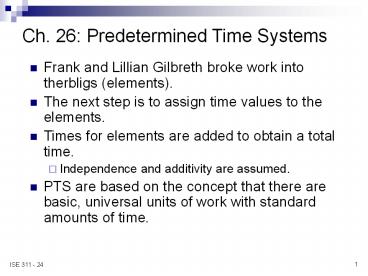Ch. 26: Predetermined Time Systems PowerPoint PPT Presentation
Title: Ch. 26: Predetermined Time Systems
1
Ch. 26 Predetermined Time Systems
- Frank and Lillian Gilbreth broke work into
therbligs (elements). - The next step is to assign time values to the
elements. - Times for elements are added to obtain a total
time. - Independence and additivity are assumed.
- PTS are based on the concept that there are
basic, universal units of work with standard
amounts of time.
2
Therbligs
- The smallest unit of activity in a task.
- Gilbreth backward (sort of)
from http//gilbrethnetwork.tripod.com/therbligs.
htmlChart
3
Methods-Time Measurements (MTM)
- Developed in 1946
- Simplified versions are available.
- A training course is required for using the
system correctly.
4
MTM-1
- 10 categories of movements
- Times in TMUs (1 TMU .000 010 h)
- Times are for an experienced worker working at a
normal pace. - No allowances are included in the times.
5
Reach (table 26.1, pg. 503)
- Reach to an object in a fixed location or in the
other hand. - Reach to a single object whose general location
is known. - Reach to an object jumbled with others in a
group. - Reach to a very small object or where accurate
grasp is required. - Reach to an indefinite location.
6
Move (table 26.2, pg. 504)
- Move object to the other hand or against stop.
- Move object to an approximate or indefinite
location. - Move object to an exact location.
7
Turn (table 26.4, pg. 506)
- A movement that rotates the hand, wrist, and
forearm about the long axis of the forearm. - Time depends on degrees of turn, weight of the
object, and resistance against turn.
Apply Pressure (table 26.5, pg. 506)
- Application of force without resultant movement.
8
Grasp (table 29.6, pg. 567)
- Pickup grasp
- Regrasp
- Transfer grasp
- Jumbled grasp
- Contact, sliding, or hook grasp
9
Position (table 26.7, pg. 508)
- Aligning, orienting, or engaging one object with
another - Position times vary with
- Amount of pressure needed to fit
- Symmetry of the object
- Ease of handling
10
Disengage (table 26.8, pg. 509)
- Breaking contact between one object and another
- Times vary with
- Class of fit
- Ease of handling
- Care in handling
11
Release (table 26.9, pg. 509)
- Relinquishing control of an object by the hand or
fingers - Two types
- Simple opening of the fingers
- Contact release
12
Other Motions
- Body, leg, and foot motions
- Eye motions
- Combined motions
- Limited motions
13
MTM Form
14
MTM-2
- Takes about 40 of the time of MTM-1 to analyze a
task. - Has only 37 times in all.
- Key categories are GET and PUT.
- Provides decision trees to determine case.
- User estimates distance and uses time from table.
- Includes 7 other motions.
15
MTM-2 Analysis
16
MTM-3
- Takes about 15 of the time of MTM-1 to analyze a
task. - Has only 10 times.
- Key categories are HANDLE and TRANSPORT.
- Provides decision trees to determine case.
- User estimates distance (lt 6 in. or gt 6 in.) and
uses time from table. - Includes 2 other motions.
17
MTM-3 Analysis
18
MOST Work Measurement System
- Based on observation that the majority of
activities are associated with a limited number
of motion sequences. - Significantly reduces time required to perform an
analysis. - 4 sequence models (pp. 513 516)
- General move sequence A B G A B P A
- Controlled move sequence A B G M X I A
- Tool use sequence A B G A B P use A B P A
- Manual crane sequence A B G M X I A, specific to
crane use.
19
General Move Sequence Model
20
Your turn
- Perform a MOST analysis of the peg board task.
- Perform a MOST analysis of writing MOST on your
notes with a pencil (assume the pencil is picked
up from the desk at the beginning and returned to
the desk at the end of the task.)
21
MODAPTS
- Based on the concept that the body member used is
the key variable. - All body movements are multiples of a MOD (1 MOD
.129 s).
22
Comments about PTS
- In theory, PTS can accurately predict task times.
- Evidence shows reality and theory dont agree.
- One problem is that analyst judgment is required.
- For the most part, consistency and cost are more
important than accuracy. - a consistent deviation from reality can be
adjusted for - Purpose of a PTS study
- use methods analysis to determine an efficient
work method - determine the amount of time necessary to do the
job

